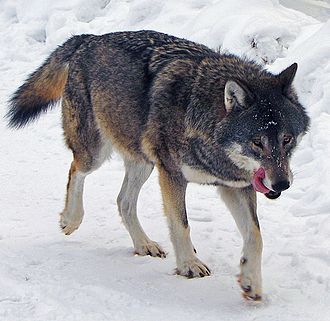- Kingdom: Animalia
- Phylum: Chordata
- Class: Mammalia
- Order: Carnivora
- Family: Canidae
- Species: C.lupus
- Genus: Canis
The wolf (Canis lupus), also known as the gray wolf or grey wolf, is a large canine native to Eurasia and North America. It is the largest extant member of Canidae, with males averaging 40 kg (88 lb) and females 37 kg (82 lb). On average, wolves measure 105–160 cm (41–63 in) in length and 80–85 cm (31–33 in) at shoulder height. The wolf is also distinguished from other Canis species by its less pointed ears and muzzle, as well as a shorter torso and a longer tail. The wolf is nonetheless related closely enough to smaller Canis species, such as the coyote and the golden jackal, to produce fertile hybrids with them. The fur of a wolf is usually mottled white, brown, gray, black, and banded. Up to 38 subspecies of wolf have been recognized including the domestic dog.
The wolf is a social animal.Its populations consist of packs and lone wolves, with most lone wolves being temporarily alone while they disperse from packs to form their own or join another one. The wolf's basic social unit is the nuclear family consisting of a mated pair accompanied by their offspring. The average pack size in North America is eight wolves and in Europe five to six wolves.[39] The average pack across Eurasia consists of a family of five to 11 wolves (two adults, three to six juveniles, and one to three yearlings),[32] or sometimes two or three such families, with examples of exceptionally large packs consisting of up to 42 wolves being known.[84] Cortisol levels in wolves rise significantly when a pack member dies, indicating the presence of stress.[85] During times of prey abundance caused by calving or migration, different wolf packs may join together temporarily.
Offspring typically stay in the pack for 10–54 months before dispersing.Triggers for dispersal include the onset of sexual maturity and competition within the pack for food.The distance travelled by dispersing wolves varies widely; some stay in the vicinity of the parental group, while other individuals may travel great distances of upwards of 206 km (128 mi), 390 km (240 mi), and 670 km (420 mi) from their natal (birth) packs.A new pack is usually founded by an unrelated dispersing male and female, travelling together in search of an area devoid of other hostile packs.Wolf packs rarely adopt other wolves into their fold and typically kill them. In the rare cases where other wolves are adopted, the adoptee is almost invariably an immature animal of one to three years old, and unlikely to compete for breeding rights with the mated pair. This usually occurs between the months of February and May. Adoptee males may mate with an available pack female and then form their own pack. In some cases, a lone wolf is adopted into a pack to replace a deceased breeder.

Wolves occurred originally across Eurasia and North America. However, deliberate human persecution because of livestock predation and fear of attacks on humans has reduced the wolf's range to about one-third of what it once was. The wolf is now extirpated (locally extinct) in much of Western Europe, the United States and Mexico, and in Japan. In modern times, the wolf occurs mostly in wilderness and remote areas. The wolf can be found between sea level and 3,000 m (9,800 ft). It lives in forests, inland wetlands, shrublands, grasslands (including Arctic tundra), pastures, deserts, and rocky peaks on mountains. Habitat use by wolves depends on the abundance of prey, snow conditions, livestock densities, road densities, human presence and topography
The wolf is a common motif in the mythologies and cosmologies of peoples throughout its historical range. The Ancient Greeks associated wolves with Apollo, the god of light and order.The Ancient Romans connected the wolf with their god of war and agriculture Mars,[158] and believed their city's founders, Romulus and Remus, were suckled by a she-wolf.Norse mythology includes the feared giant wolf Fenrir, eldest child of Loki and the giantess Angrboda,and Geri and Freki, Odin's faithful pets.The wolf was held in high esteem by the Dacians, who viewed it as the lord of all animals and as the only effective defender against evil.
In the Pawnee creation myth, the wolf was the first animal brought to Earth. When humans killed it, they were punished with death, destruction and the loss of immortality. For the Pawnee, Sirius is the "wolf star" and its disappearance and reappearance signified the wolf moving to and from the spirit world. Both the Pawnee and Blackfoot call the Milky Way the "wolf trail". In Chinese astronomy, the wolf represents Sirius as the "blue beast" and the star itself is called the "heavenly wolf".Tengrism places high importance on the wolf, as it is thought that, when howling, it is praying to Tengri, thus making it the only creature other than man to worship a deity.
The concept of people turning into wolves has been present in many cultures. One Greek myth tells of Lycaon of Arcadia being transformed into a wolf by Zeus as punishment for his evil deeds. The legend of the werewolf has been widespread in European folklore and involves people willingly turning into wolves to attack and kill others. The Navajo have traditionally believed that witches would turn into wolves by donning wolf skins and would kill people and raid graveyards. The Dena'ina believed wolves were once men and viewed them as brothers